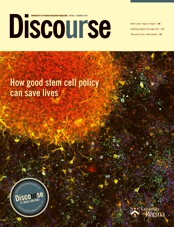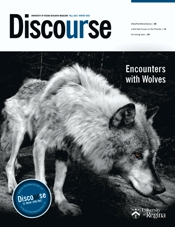Madelyn and Judith Fix-Vall in their yard with U of R biology student Joshua Christiansen. (Photo by Trevor Hopkin)

“I like that they eat mosquitoes,” says six-year-old Judith Fix-Vall, sitting in her Regina backyard dressed in a bat costume on a hot July afternoon.
Her sister, nine-year-old Madelyn, is surprised bats visit her backyard at all.
“We’ve never even seen any!” she exclaims.
But just because Judith and Madelyn, and perhaps many other Regina residents, haven’t seen bats, doesn’t mean they aren’t swooping into their backyards all spring, summer, and fall.
“While we know bats are around, we don’t know if urban noise impacts their nocturnal activities,” says undergraduate biology student Carlie Hinz, who is working with fellow biology student Joshua Christiansen on this research project.
“While we know bats are around, we don’t know if urban noise impacts their nocturnal activities.”
To find out how city noise affects bats, the researchers first sent an email through the University looking for backyards.
“Within hours, we received more than 100 responses from people all over the city who wanted to be part of the study,” says Christiansen. “We then chose 42 sites based on location and paired up yards that were about 200 metres apart, where one was in a considerably noisier location than the other.”
The Fix-Vall yard was one of the lucky ones that became part of the study.
“Theirs is a loud site because it borders two busy Regina streets. Their quiet paired location is a few blocks away. Both are between 50 and 100 metres from Wascana Creek,” says Christiansen.

To control for as many external factors as possible, and to allow the biologists to isolate noise as the main factor that might impact bat activity, they recorded both sites at the same time so each site had the same variables, such as moonlight and weather.
The researchers also put out a second set of detectors to collect base ambient noise in order to confirm if the chosen sites were as quiet and as noisy as they anticipated.
“Each detector was set up in a pair of yards for seven nights. We repeated this twice more for two months. Halfway through each week we went and downloaded data from the detector and ran it through our software program, which lowered the sound frequency, allowing us to establish which bat species was being detected,” says Hinz, who adds that while the program auto-identifies the bats, they double check for accuracy.
Christiansen notes that the detectors are set to only pick up high-frequency sounds, like the ones bats emit when they echolocate. Low-frequency sounds like the human voice weren’t detected.
“Bats send out a high-frequency sound – one that is much higher than the human ear can hear. It’s how they move around in the dark. Their sound bounces off of objects and back to them, which helps them commute to and from their roosts and back and forth from foraging areas,” says Hinz.

City noises, particularly traffic, also emit high-frequency sounds that could make echolocation difficult for bats.
“A bat could, for example, receive an echolocation that isn’t their call, but is rather a car or an air conditioner, and that could cut off their route to a food source. This would mean that urban noises could be negatively impacting how bats travel and find food,” explains Hinz.
Prior to starting their research, the two hypothesized that more noise would lead to less bat activity.
“Our preliminary research provides support for our hypothesis that quiet sites would have more bat calls. But we haven’t yet finished the analysis,” says Christiansen.
Hinz says a lot of published research has focused on how highways in rural areas impact bats, but few studies have narrowed in on urban traffic noise. Other studies on noise have taken place in labs using simulated noises and conditions.
“Our project will add to research that pertains to bat activity within city limits, and within a natural urban environment with real traffic versus little to no traffic.”
The researchers are proud that their work will be useful, and are excited that they found more than they were looking for while doing their field work.
“I couldn’t believe how invested people were in our project, how much they wanted to chat and ask questions. And COVID-19 restrictions meant most people were at home and could engage with us when we came,” says Christiansen
“One little boy asked if I was a scientist. When I told him I was, he asked where my goggles and big white coat were! One parent had her young daughter come out to meet me, a female scientist. That was really meaningful.”
Hinz says kids that were home when they arrived added even more fun.
“One little boy asked if I was a scientist. When I told him I was, he asked where my goggles and big white coat were! One parent had her young daughter come out to meet me, a female scientist. That was really meaningful.”
Something that amazed sisters Madelyn and Judith on the day Christensen came to collect data from their detector also surprised the researcher. “We’re still working with preliminary data, but it looks like their backyard had more than 2,000 bat visits in one week alone!”

Hinz was also surprised that there were bats detected in every yard they tested.
“We detected bat calls in backyards in the suburbs, near the outskirts of town, and fairly far from a water source. We discovered just how present bats are in the city, and how few people know they’re around.”
Hinz says it’s a good sign that bats are everywhere.
“Because even if you don’t notice them,” says Hinz, “having a healthy bat population indicates a healthy ecosystem.”












